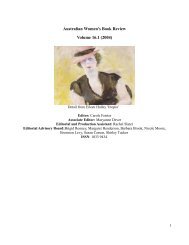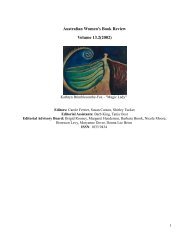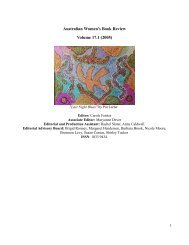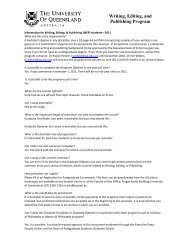Australian Women's Book Review Volume 14.1 - School of English ...
Australian Women's Book Review Volume 14.1 - School of English ...
Australian Women's Book Review Volume 14.1 - School of English ...
You also want an ePaper? Increase the reach of your titles
YUMPU automatically turns print PDFs into web optimized ePapers that Google loves.
principally to comfortable or aspiring white middle class readers; the existence <strong>of</strong> migrant women,<br />
<strong>Australian</strong> born working class women and Aboriginal women was only intermittently acknowledged in<br />
the pages <strong>of</strong> the magazine and they were seldom addressed as readers.<br />
The core <strong>of</strong> Who Was That Woman? consists <strong>of</strong> chapters covering key facets <strong>of</strong> femininity and<br />
domesticity: the housewife as consumer; sex, romance and marriage; motherhood; women's paid and<br />
unpaid work; house and garden; food and cooking; health; and fashion and beauty. If the Weekly was -<br />
and remains - a socially conservative publication, it is evident that it did still move with the times (even<br />
if it was rarely ahead <strong>of</strong> them). Sheridan's detailed chapters carefully elaborate the successive<br />
discursive regimes that were employed across different decades to accommodate changing<br />
understandings <strong>of</strong> marriage, motherhood, and homemaking. Of particular interest is the Weekly's<br />
uneasy relationship to the notion <strong>of</strong> 'careers' for women and to the practice <strong>of</strong> married women<br />
undertaking paid work outside the home, two phenomena not readily reconciled with the magazine's<br />
promotion <strong>of</strong> domesticity and full-time motherhood as rightful and fulfilling feminine destinies.<br />
Sheridan traces the contradictions and anxieties surrounding these issues, and they are also taken up by<br />
Lyndall Ryan in her lively memoir section, 'Remembering the <strong>Australian</strong> <strong>Women's</strong> Weekly in the 1950s.'<br />
By the 1960s, the appearance <strong>of</strong> articles such as 'Meals Made in Minutes' showed growing recognition<br />
within the magazine that at least some readers were 'working wives' or 'two job mothers', as they<br />
termed them. Despite this, the Weekly's continuing dedication to particular models <strong>of</strong> domestic<br />
womanhood and family life in the face <strong>of</strong> the development <strong>of</strong> the <strong>Women's</strong> Liberation Movement and<br />
accompanying the rise in middle-class women's participation in paid employment, was apparently what<br />
contributed to its loss <strong>of</strong> influence in the 1970s.<br />
There are genuine pleasures here for the contemporary reader seeking insights into the changing<br />
material conditions <strong>of</strong> <strong>Australian</strong> women's lives across these decades and into changing ideals <strong>of</strong><br />
<strong>Australian</strong> womanhood. While labour-saving devices abound in advertisements, domestic life<br />
nevertheless remained labour intensive and standards <strong>of</strong> household management high. Highlysegregated<br />
gender roles in the post-war decades <strong>of</strong>fered little possibility for the sharing <strong>of</strong> domestic<br />
chores. While references did appear in the magazine to a condition known simply as 'housewife blues',<br />
the dominant images are <strong>of</strong> ecstatic and glamourised engagements with an endless round <strong>of</strong> domestic<br />
tasks, all presented as pleasant duties rather than dull and repetitive burdens. In this era <strong>of</strong> fast food and<br />
domestic de-skilling, some younger readers might well marvel that anyone would want - let alone have<br />
been able - to crochet their own wedding dress (p.40) or produce an afternoon tea-cake in the shape <strong>of</strong> a<br />
vase <strong>of</strong> sweetpeas ('flower moulding in fondant is not as difficult as it may appear' p.93). More still<br />
might marvel that the ideal swimsuit model <strong>of</strong> the 1950s weighed in at 10 stone. The pleasures <strong>of</strong><br />
reading this work are increased by the lavish level <strong>of</strong> illustration that provides readers unfamiliar with<br />
the magazine in this period ready access to key elements <strong>of</strong> the Weekly's visual presentation. I have no<br />
doubt that Who Was That Woman? The <strong>Australian</strong> <strong>Women's</strong> Weekly in the Postwar Years will become a<br />
valuable resource for researchers and students in history, cultural studies, media and women's studies.<br />
In its successful synthesis <strong>of</strong> contemporary feminist approaches to women's magazines it <strong>of</strong>fers an<br />
excellent model for reading and writing social history through popular culture.<br />
Maryanne Dever is Director <strong>of</strong> the Centre for <strong>Women's</strong> Studies and Gender Research at Monash<br />
University. Her many publications include editing Wallflowers and Witches: Women and Culture<br />
in Australia 1910-1945, St Lucia: University <strong>of</strong> Queensland Press, 1994.<br />
35








